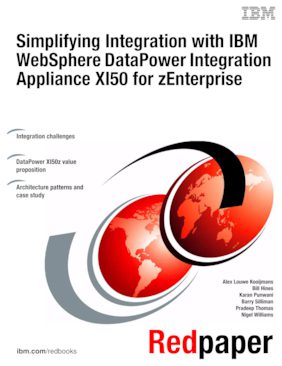Abstract
This IBM® Redpaper™ publication illustrates how the IBM WebSphere DataPower Integration Appliance XI50 for zEnterprise provides a secure, fast, cost-effective, easy-to-manage, all-in-one enterprise application integration solution. On top of all the benefits that the DataPower XI50 and XI52 already provide, incorporating the DataPower XI50z into zEnterprise also provides a number of additional benefits:
- Exploitation of the high-speed intraensemble data network (IEDN) connecting the zEnterprise Blade Extension (zBX) with the zEnterprise central processor complex (CPC), either a zEnterprise 196 (z196) or zEnterprise 114 (z114)
- Secure incorporation of the DataPower XI50z appliance into a virtual local area network (VLAN) on the zBX
- Unified management of the DataPower XI50z, along with other blades and optimizers using a common management tool
- A centralized computing model, resulting in more efficient use of floor space, lower energy costs, and a lower total cost of ownership (TCO)
The DataPower XI50z provides a variety of powerful integration scenarios specifically for older mainframe applications, making it a natural choice to include the appliance in your centralized zEnterprise server.
This publication is intended for potential and actual users of the DataPower XI50z.
Table of Contents
Chapter 1. Introduction
Chapter 2. Smarter computing with zEnterprise
Chapter 3. Improving business agility
Chapter 4. Managing risk
Chapter 5. Managing IT infrastructure complexity
Chapter 6. Reducing IT costs
Chapter 7. Banking case study
